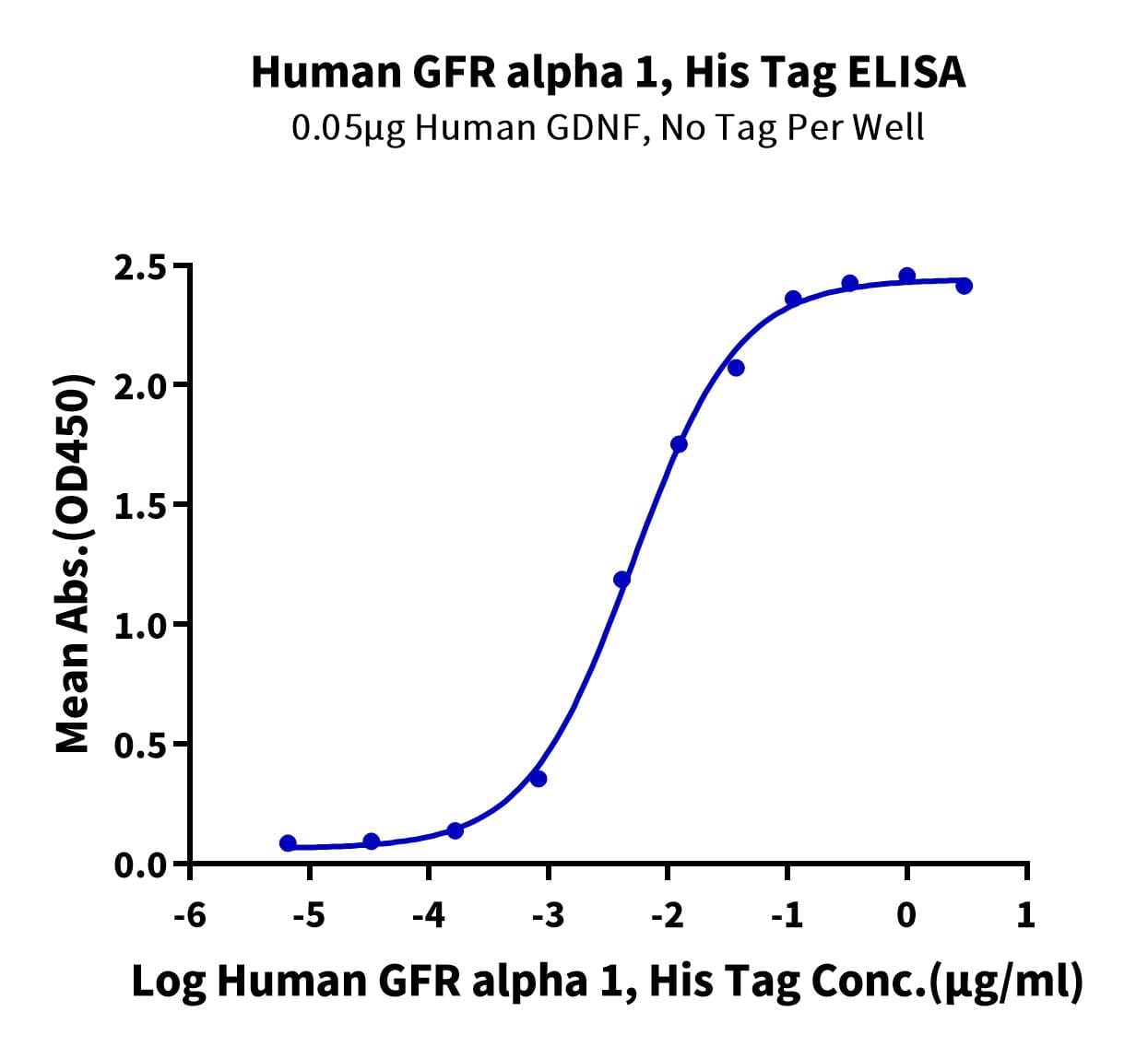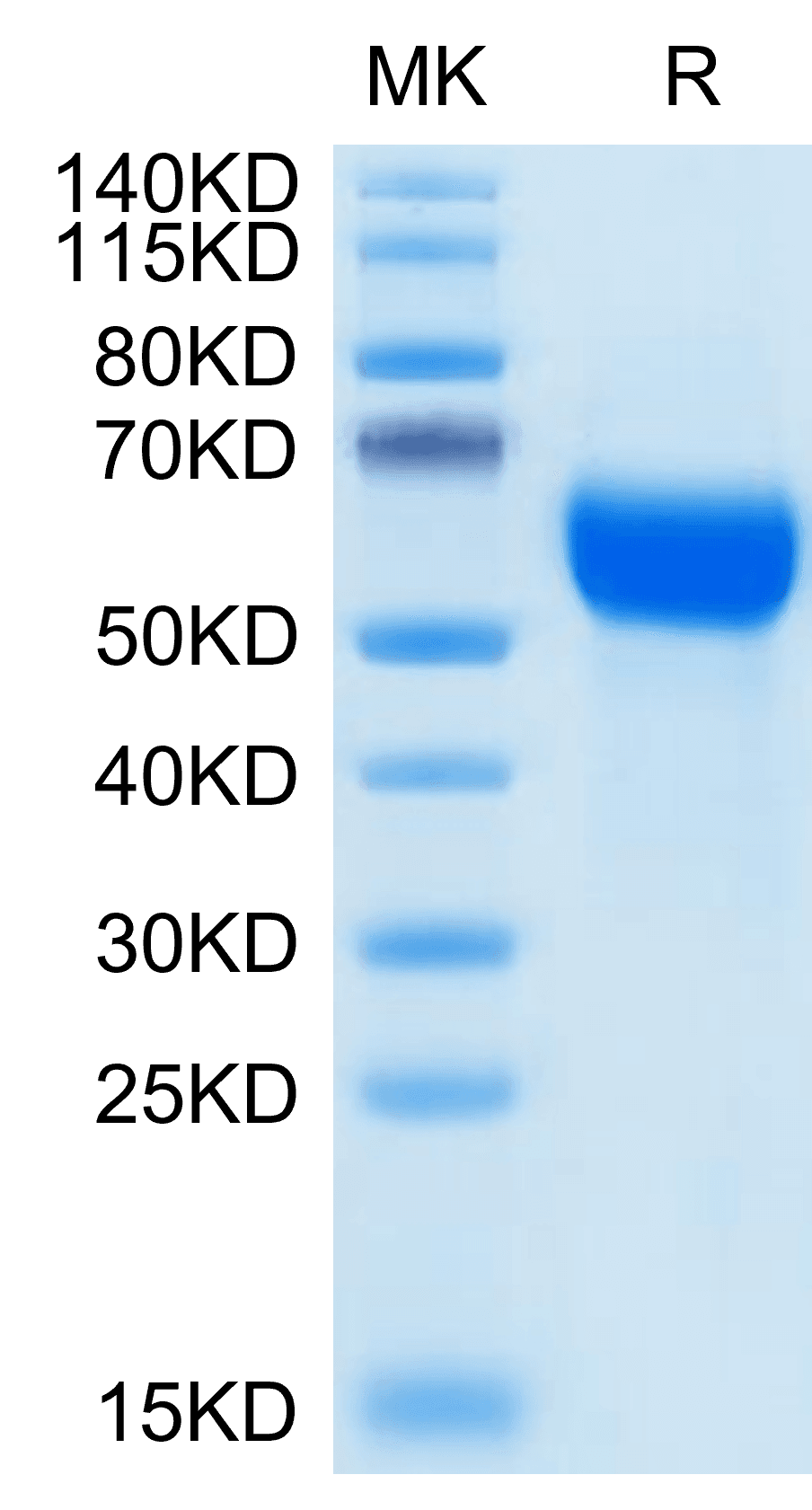| Weight | 1 lbs |
|---|---|
| Dimensions | 9 × 5 × 2 in |
| accession | NP_665736 |
| express system | HEK293 |
| product tag | C-His |
| purity | > 95% as determined by Tris-Bis PAGE;> 95% as determined by HPLC |
| background | Neuroblastomas often undergo spontaneous differentiation and/or regression in vivo, which is at least partly regulated by the signals through neurotrophins and their receptors. Recently, glial cell line-derived neurotrophic factor (GDNF) and a second family member, neurturin (NTN), have been found to mediate their signals by binding to a heterotetrameric complex of c-Ret tyrosine kinase receptors and glycosylphosphatidylinositol-linked proteins, GFR alpha-1 (GDNFR-alpha) or GFR alpha-2 (TrnR2/GDNFR-beta/NTNR-alpha/RETL2). |
| molecular weight | The protein has a predicted MW of 45.8 kDa. Due to glycosylation, the protein migrates to 50-70 kDa based on Tris-Bis PAGE result. |
| available size | 100 µg, 500 µg |
| endotoxin | Less than 1EU per μg by the LAL method. |
Human GFR alpha 1 Protein 4134
$210.00 – $700.00
Summary
- Expression: HEK293
- Functional: Yes (ELISA)
- Amino Acid Range: Asp25-Ser424
Human GFR alpha 1 Protein 4134
| protein |
|---|
| Size and concentration 100, 500µg and lyophilized |
| Form Lyophilized |
| Storage Instructions Valid for 12 months from date of receipt when stored at -80°C. Recommend to aliquot the protein into smaller quantities for optimal storage. Please minimize freeze-thaw cycles. |
| Storage buffer Shipped at ambient temperature. |
| Purity > 95% as determined by Tris-Bis PAGE |
| target relevance |
|---|
| Neuroblastomas often undergo spontaneous differentiation and/or regression in vivo, which is at least partly regulated by the signals through neurotrophins and their receptors. Recently, glial cell line-derived neurotrophic factor (GDNF) and a second family member, neurturin (NTN), have been found to mediate their signals by binding to a heterotetrameric complex of c-Ret tyrosine kinase receptors and glycosylphosphatidylinositol-linked proteins, GFR alpha-1 (GDNFR-alpha) or GFR alpha-2 (TrnR2/GDNFR-beta/NTNR-alpha/RETL2). |
| Protein names GDNF family receptor alpha-1 (GDNF receptor alpha-1) (GDNFR-alpha-1) (GFR-alpha-1) (RET ligand 1) (TGF-beta-related neurotrophic factor receptor 1) |
| Protein family GDNFR family |
| Mass 51456Da |
| Function Coreceptor for GDNF, a neurotrophic factor that enhances survival and morphological differentiation of dopaminergic neurons and increases their high-affinity dopamine uptake (PubMed:10829012, PubMed:31535977). GDNF-binding leads to autophosphorylation and activation of the RET receptor (PubMed:31535977). {ECO:0000269|PubMed:10829012, ECO:0000269|PubMed:31535977}. |
| Subellular location Cell membrane {ECO:0000250|UniProtKB:Q62997}; Lipid-anchor, GPI-anchor {ECO:0000250|UniProtKB:Q62997}. Golgi apparatus, trans-Golgi network {ECO:0000250|UniProtKB:Q62997}. Endosome {ECO:0000250|UniProtKB:Q62997}. Endosome, multivesicular body {ECO:0000250|UniProtKB:Q62997}. Note=Localizes mainly to the plasma membrane. In the presence of SORL1, shifts to vesicular structures, including trans-Golgi network, endosomes and multivesicular bodies. {ECO:0000250|UniProtKB:Q62997}. |
| Structure Interacts with GDNF ligand and RET: forms a 2:2:2 ternary complex composed of GDNF ligand, GFRA1 and RET receptor (PubMed:23333276, PubMed:31535977). Interacts with SORL1, either alone or in complex with GDNF (PubMed:23333276). Interaction between SORL1 and GFRA1 leads to GFRA1 internalization, but not degradation (PubMed:23333276). {ECO:0000269|PubMed:23333276, ECO:0000269|PubMed:31535977}. |
| Target Relevance information above includes information from UniProt accession: P56159 |
| The UniProt Consortium |
Data
Publications
Publications
| pmid | title | authors | citation |
|---|---|---|---|
| We haven't added any publications to our database yet. | |||
Protocols
| relevant to this product |
|---|
Documents
| # | ||
|---|---|---|
| Please enter your product and batch number here to retrieve product datasheet, SDS, and QC information. | ||

















